NHS England chief executive Simon Stevens has said the NHS needs to recommit to exploiting the potential of anonymised clinical data for driving research and innovation.
Stevens announced that the NHS will set-up two to five regional Digital Innovation Hubs, each covering regions of 3-5 million people. “We need to advance on exploiting anonymised clinical data.”
“We have had a number of false starts and false dawns,” he acknowledged, an apparent reference to the botched national Care.data programme that was ended after failing to address patient privacy concerns.
Stevens said that NHS England accepted the recommendations of Sir John Bell’s August Life Sciences Industrial Strategy, which called for the creation of the new Digital Innovation Hubs to rapidly enable researchers to engage with a meaningful dataset.
Speaking at NHS Expo on Tuesday, Stevens said, “NHS England is backing those recommendations from Sir John Bell’s report and we will by end of year set out how with NHS Digital will go live with 2-5 Digital Innovation Hubs each covering 3-5 million people.”
Stevens said that the landmark Salford Lung Study, which has focused on COPD and Asthma data, provided an example of the power of providing patient data sets into the hands of researchers.
The NHS had to get information governance right but couldn’t afford to forgo the benefits to patients of its unique data assets, he added, “If the shutters come down we won’t be able to see the benefit.”
In a speech that highlighted multiple examples of innovation and use of digital and medical technologies from across the NHS, Stevens said. “I defy anyone who says the NHS is stuck in mud. The NHS is a hotbed of innovation. But we need to go faster, further.”
As well as committing to establish the new Digital Innovation Hubs the NHS England boss outlined plans to expand and extend NHS Test Beds.
“Last January we launched the NHS Test Beds and got seven sites across the country – with 40 innovators and eight evaluation teams. We now have 4,000 patients enrolled in initiatives that range from medical devices to internet of things.”
“Our aim is to get those 4,000 patients up to 15,000 by this time next year. And we are announcing that we will extend funding for the Test Beds for another two years.”
Further investment was promised in accelerating adoption of Artificial Intelligence and Machine Learning. Stevens cited a recent Lancet editorial as pointing to the potential of these emerging technologies to transform scan analysis of radiology and pathology images.
“Sir John Bell’s report identified the faster application of AI as a priority area and as we make case for investment NHS England will be backing that with our investment over course of the next 12 months.”
The NHS England chief exec also pointed to the innovation and tech tariff introduced in April, designed to enable the best innovations to get reimbursed directly “to cut out faff of getting innovations into practice”.
NHS England will now extend the innovation and tech tariff into primary care and expanding into Primary Care, and has already had 230 applications.
“There is a huge hunger for innovation across the service. There is a lot in train and in prospect, but we need to move faster.”


21 September 2017 @ 13:39
Tom, regarding what what you say about Jeff Bezos, every day individuals give the likes of Amazon, Google and LinkedIn huge amounts of personal data without even knowing or even caring, how it will be used – try to do that within the NHS with health data and suddenly everyone is shocked and dismayed that this could happen without them being aware of every single bit of information being shared, opting out sharing certain bits of data with certain care professionals. Yes there needs to be transparency and anonymisation of data and a clear time line of who is using it and to what purposes and this needs to be shared with those whose data is being used.
15 September 2017 @ 16:31
“I defy anyone who says the NHS is stuck in the mud…we need to go faster, further.”
Consider yourself defied JH…you see each persons NHS is “their own NHS” and our own experiences are all we have, rhetoric means little in the patient’s world. I cannot access medical records through my GP Practice, the website is like something a student in the 90s would have built, the hospital has no EPR and there is no online support for mental health. The NHS I use and I pay for is stuck in the mud, but the bloke that sells me books called Jeff Bezos, well he knows more about me than my own National Health Service; don’t talk the talk unless you are on solid ground…and please stop saying you need to go faster, NHS initiatives just keep falling over in our unthinking era of “scale and pace”.
15 September 2017 @ 08:03
“Would you be a Digital Donor?” https://www.linkedin.com/pulse/would-you-digital-donor-stephen-slough